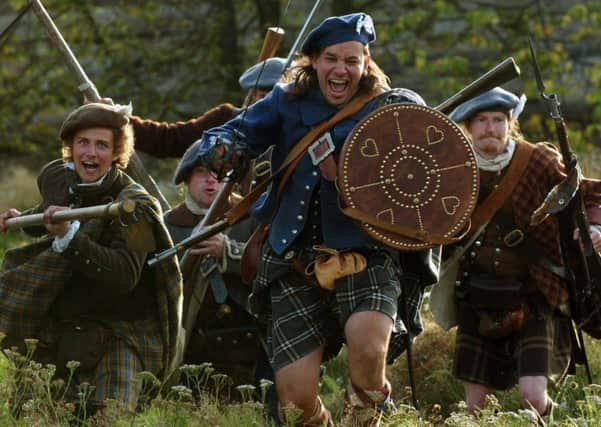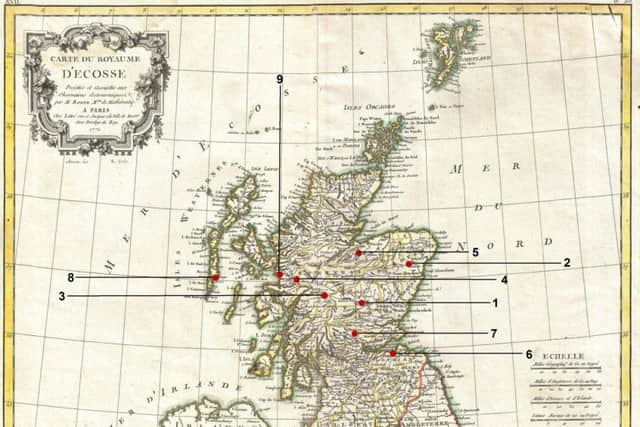In pictures: A Jacobite trail around Scotland in 9 sites


And following the international success of Diana Gabaldon’s Outlander novels and television series, interest in the Jacobite rebellions has increased tenfold in recent years.
But unlike Outlander lead Claire Randall, most of won’t have access to a magical stone circle to whisk us back to the 18th century.
Advertisement
Hide AdFor those who wish to get up close and personal with Jacobite history, however, there are scores of plaques, memorials and monuments out there marking the sites where rebellious dreams were both forged and extinguished.


From 1689 the ‘braes o’ Killicrankie-O’ to the ivory sands of Eriskay, we take a look at nine of Scotland’s most prominent Jacobite sites.
1. Killiecrankie, Perthshire
The Battle of Killiecrankie, took place on 27 July 1689 less than a year after the Glorious Revolution ousted the Catholic James II and VII from the British throne. Won by the Jacobites, the battle witnessed the first major engagement of the rebellions, upsetting this normally tranquil gorge at Pitlochry. One government soldier famously escaped the battlefield by making a brave leap across a narrow stretch of the River Garry. Today that spot is known as Soldier’s Leap. The battle was later immortalised by national bard Robert Burns, whose words provided the basis for what is now a well-known folk song, The Braes of Killiecrankie.
2. Castle Fraser, Aberdeenshire


Outlander author Diana Gabaldon deserves a special mention in our tour for raising the profile of the Jacobite rebellions, particularly ‘the 45’. In her series of novels her male lead is a dashing young Highlander named Jamie Fraser, whose real life clan played a pivotal role during the final uprising. The Frasers were among the most ardent supporters of the Jacobite cause and many of their number were among the hundreds of casualties at Culloden. Castle Fraser, the medieval stronghold of the Clan Fraser, is located near Kemnay in Aberdeenshire and looks much the same today as it would have in the 18th century.
3. Glencoe, Highlands
The stunning natural landscape at Glencoe provided the backdrop for one of the darkest events in Scottish history. The Massacre of Glencoe occurred in February 1692 when thirty-eight members of the Clan MacDonald, supporters of the 1689 rebellion, were slaughtered by government troops. Hundreds more are thought to have perished from exposure in the aftermath.
4. Glenfinnan Monument, Lochaber
Located in the Lochaber close to the banks of Loch Shiel, the Glenfinnan Monument marks the spot where Prince Charles Edward Stuart, the Young Pretender, raised his standard to signal the start of the 1745 Jacobite rebellion. The monument consists of a lone kilted Highlander standing atop an 18-metre-high stone column, a tribute to the men who fought for the Stuart cause.
5. Culloden Moor, Inverness
Advertisement
Hide AdAt Culloden Moor on 16 April 1746, the Duke of Cumberland’s army brought the final rebellion to a bloody, brutal close, as an estimated 1500 of Bonnie Prince Charlie’s men fell to their knees in less than an hour. The fateful Battle of Culloden turned out to be the last pitched battle to be fought on British soil. A solemn eeriness still pervades this marshy stretch of land.
Headstones marking the mass graves of the fallen Jacobite soldiers and their many clans were laid around the battlefield in 1881. These still stand today.
6. Prestonpans, East Lothian
Advertisement
Hide AdThe Battle of Prestonpans is seen by many as the moment the ‘45 rebellion truly kicked off. Charles Edward Stuart’s Jacobites wreaked devastation on a government army led by Sir John Cope, who suffered terrible casualties. The battle lasted just 15 minutes. A cairn located just outside the town of Tranent marks the spot the battle took place.
7. Sheriffmuir, Stirling
Led by John Erskine, Earl of Mar, the Jacobite rising of 1715 was a failure framed by the Battle of Sheriffmuir. History regards the clash as a stalemate, with both sides claiming victory. Many on the Jacobite side, whose army of 12000 was double that of the government forces, felt they should have emerged as clear victors on account of having far greater numbers. Following the battle, the Jacobite army was left feeling demoralised and down-beat. The ‘15 rising fizzled out soon after. Robert Burns’ song The Battle of Sherramuir, remains among the poet’s most celebrated works.
8. Eriskay, Outer Hebrides
Not content with its distinction as the real location of Whisky Galore!, the tiny island of Eriskay also played a starring role at the very start of the 1745 Jacobite rising. On 23 July 1745, Bonnie Prince Charlie and his seven companions known as the Men of Moidart, anchored their ship the Du Tellay off the coast here. A small cairn marks the spot they landed.
9. Loch Nan Uamh, Lochaber
From the place he arrived to the place he left. A cairn at Loch nan Uamh commemorates the spot that Princes Charles Edward Stuart fled for France aboard the ironically-named frigate L’Heureux. The prince had spent four long months evading Redcoats following the disastrous Battle of Culloden. His dream of gifting his father the British throne in tatters, Charles left Scotland on 20 September 1746 a broken man. He would never return.